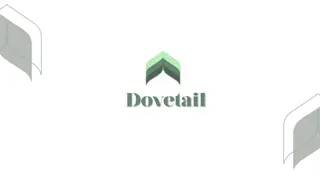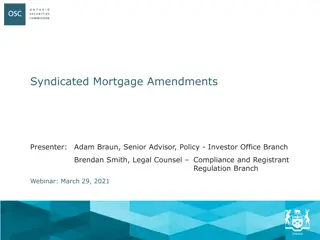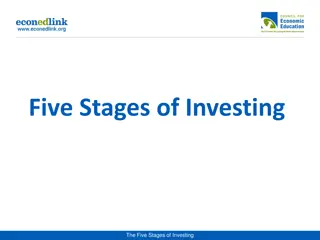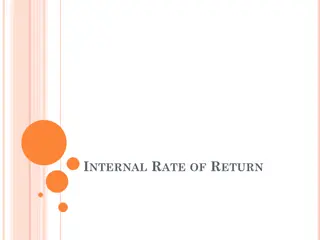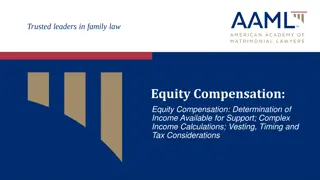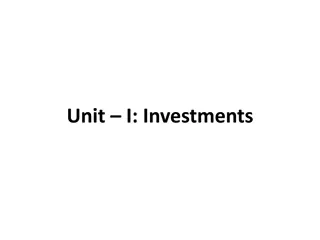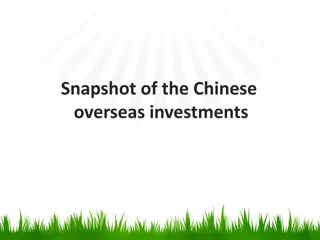
Exploring Business Investments: Functions, Types, and Risks
Dive into the world of investments with a focus on the functions of the JSE, various types of investment opportunities, factors influencing investment decisions, and the pros and cons of different forms of investments. Learn about shares, preference shares, debentures, dividends, interest calculations, and how to choose the best investment option based on calculations.
Download Presentation

Please find below an Image/Link to download the presentation.
The content on the website is provided AS IS for your information and personal use only. It may not be sold, licensed, or shared on other websites without obtaining consent from the author. If you encounter any issues during the download, it is possible that the publisher has removed the file from their server.
You are allowed to download the files provided on this website for personal or commercial use, subject to the condition that they are used lawfully. All files are the property of their respective owners.
The content on the website is provided AS IS for your information and personal use only. It may not be sold, licensed, or shared on other websites without obtaining consent from the author.
E N D
Presentation Transcript
Building Blocks for Growth CHIEF DIRECTORATE: CURRICULUM MANAGEMENT 2020 LEARNER SUPPORT VIRTUAL LESSON BUSINESS STUDIES GRADE 12 TERM 2 LESSON: INVESTMENTS - SECURITIES MRS K. MGIJIMA 1
CONTENT LAYOUT (According to Exam Guidelines 2020) CONTENT LAYOUT (According to Exam Guidelines 2020) Learners must be able to: Outline/Explain/Discuss the functions of the JSE. Investigate a range of available business investment opportunities. Outline/Mention/Describe/Explain/Discuss the following factors that should be considered when making investment decisions: Return of investment (ROI), Risk, Investment period/term, Inflation rate, Taxation, Liquidity, Personal budget, Investment planning factors, Volatility/Fluctuations on investment markets Explain/Discuss the various types of investments opportunities e.g. fixed property, stokvels, managed portfolio, venture capital etc. Explain the risk factor of each type of investment opportunity.
CONTENT LAYOUT CONTENT LAYOUT ( (Cont Cont ) ) Explain/Discuss/Analyse/Evaluate (positives/advantages and/or negatives /disadvantages) of the following forms of investment: Government/RSA retail savings bonds , Unit trusts, Shares, Fixed deposit Identify the following types of shares from given scenarios/statement: Ordinary shares Preference shares Bonus shares Founders shares
CONTENT LAYOUT ( CONTENT LAYOUT (Cont Cont ) ) Name/Outline/Explain/Discuss types of preference shares. Outline/Mention the rights of ordinary and preference shareholders. Identify types of preference shares from given scenarios/statements. Differentiate/Distinguish between ordinary and preference shares. Define/Explain the meaning of debentures, dividends, capital gain, simple interest, compound interest. Differentiate/Distinguish between simple interest and compound interest. Calculate simple and compound interest from given scenarios. Recommend the best investment option based on the calculations.
Functions of the JSE Functions of the JSE Gives opportunities to financial institutions such as insurance companies to invest their funds in shares. Serves as a barometer/indicator of economic conditions in South Africa. Keeps investors informed on share prices by publishing the share prices daily. Acts as a link between investors and public companies. Shares are valued and assessed by experts. Encourages new investments. Raises primary capital. Regulates the market for dealing with shares. Ensures that the market operates in a transparent manner. Provides protection for investors. Encourages short-term investment.
Factors Factors that should be considered when making that should be considered when making investment decisions investment decisions 1. Return on investment Refers to income from the investment, namely interest/dividends/increased capital growth on the original amount invested. High risk investments yield higher returns. Generally, there will be a direct link between risk and return. Returns can be in the form of capital gains where the asset appreciates in value over time.
Factors that should be considered when Factors that should be considered when making investment making investment decisions ( decisions (Cont Cont ) ) 2. Risk low/medium/ high risk depending on an investment period. The higher the risk the higher the return Possibility of not being paid back the capital invested
Factors that should be considered when Factors that should be considered when making investment decisions ( making investment decisions (Cont Cont ) ) 3. Investment period This refers to the duration of the investment which may influence the return on investment. The longer the investment period the higher the returns. Short term investments enable investors to access their money on a short period if needed. The investment period can be short, medium and/or long term depending on the investors needs.
Factors that should be considered when Factors that should be considered when making investment decisions ( making investment decisions (Cont Inflation rate People are affected by a high inflation rate, because their purchasing power decreases. The return on investment should be higher than the inflation rate. Inflation has a positive effect on some investments such as property/shares where the income will increase as inflation increases. Personal budgets Investors can determine the amount of surplus money that can be invested. Investors must budget for unforeseen costs. Budget should provide for contingency plans/investments/savings. Cont ) )
Factors that should be considered when Factors that should be considered when making investment decisions ( making investment decisions (Cont Cont ) ) Liquidity Amount invested can easily be converted to cash. The ease and speed with which investors can convert an investment into cash. Example: an investment in a savings account/unit trust will be easier to convert into cash than an investment in a fixed deposit which is usually deposited for a fixed period of time. Taxation A good investment will yield good after-tax returns. Income tax implications must be considered in order to ensure a high net after- tax return. Tax rates are not necessarily the same for different investments.
Factors that should be considered when Factors that should be considered when making investment decisions ( making investment decisions (Cont Cont ) ) Investment planning factors Investors should always consider the safest possible investment opportunities Examine opportunities with a history of good return. Divide investments between various investment options. The method of calculating the interest/return on investment should be considered. Volatility/Fluctuations on investment markets Fluctuation in national and international economic trends should be considered. The level of volatility will determine the amount of returns.
TYPES OF INVESTMENT OPPORTUNITIES AND RISK FACTORS Investment opportunity Explanation Risk factor Buying a house/piece of land is usually suitable as a long term investment only. Return on property is earned in the form of rental/sales/capital gains at a higher price than what it was bought for The location/size of the property may also influence the growth in value over time. Low risk over a long term. Risk may be determined by economic conditions and may influence the value of property Fixed property
TYPES OF INVESTMENT OPPORTUNITIES AND RISK FACTORS (Cont..) Investment opportunity Explanation Risk factor An informal savings scheme to which a relatively small group of people contribute Usually managed by a trustworthy chairman/treasurer Members usually discuss how the money will be invested and agree on the risks they are willing to take. Mutual funds/Stokvels Money in a savings account is a safe investment, but with low interest rates/the returns are low.
TYPES OF INVESTMENT OPPORTUNITIES AND RISK FACTORS (Cont..) Investment opportunity Explanation Risk factor An investor instructs a financial institution/financial advisor to manage his/her various investments in one portfolio. If the portfolio does not perform well, the portfolio/parts thereof may be changed with/without informing the investor Risk is lower over a longer term. Risk is spread and better managed by the portfolio manager. High risk over the short term. Managed portfolio
TYPES OF INVESTMENT OPPORTUNITIES AND RISK FACTORS (Cont..) Investment opportunity Explanation Risk factor Fixed deposit Investment at a fixed rate for a fixed period at a financial institution Money cannot be withdrawn/added during the period of the deposit. Investors have to be certain that they will not access/need the money for the period of the deposit. Low risk as the investor will receive what was promised. As the interest rate is usually fixed, the return will not be affected by market fluctuations.
TYPES OF INVESTMENT OPPORTUNITIES AND RISK FACTORS (Cont..) Investment opportunity Explanation Risk factor Money is invested at a fixed rate, although withdrawals may be made provided the bank is given 32 days' notice of the withdrawal. It earns more interest than a current/cheque/savings account, but less interest than a fixed deposit. Low risk Interest rate may fluctuate with market conditions, increasing the risk. 32-day notice accounts/Call Deposits
TYPES OF INVESTMENT OPPORTUNITIES AND RISK FACTORS (Cont..) Investment opportunity Explanation Risk factor Issued to raise borrowed capital from the public. The lender/debenture holder agrees to lend money to the company on certain conditions for a certain period. Debenture holders are creditors, as the company is liable to repay the amount of the debentures. Debenture holders receive annual interest payments based on the terms/ amount of debentures held. low risk . Companies are liable to repay the amount of the debenture plus interest, which decrease the risk for the investor. Debentures
TYPES OF INVESTMENT OPPORTUNITIES AND RISK FACTORS (Cont..) Investment opportunity Explanation Risk factor Given by an investor to start up/expand a business in return to have a share in the new/expanded business. Buying a franchise/existing businesses will be successful, if the investors has done proper research/understand exactly what he/she is investing in. High risk for the investor(s), if research is not properly done. Inexperienced business owners that make wrong business decisions may experience big losses/closing down of an existing business. Business Ventures/Ventur e capital
TYPES OF INVESTMENT OPPORTUNITIES AND RISK FACTORS (Cont..) Investment opportunity Explanation Risk factor Endowment/Life insurance policies/Retirem ent Annuities A monthly payment is paid to an insurance company with the expectancy of receiving a pre-determined amount on a date in the future. To provide for a future expenses/give peace of mind to the dependants of the insured. Low risk Only the closing down of the insurance company may result in losing the monthly contributions made up to the close down date.
TYPES OF INVESTMENT OPPORTUNITIES AND RISK FACTORS (Cont..) Investment opportunity Explanation Risk factor collection of investment options made up of shares in different companies. Investments of a number of investors are pooled together in a unit trust fund, managed by a fund/portfolio manager/expert. high and low risk shares, which spread the risk throughout the fund Unit trusts
TYPES OF INVESTMENT OPPORTUNITIES AND RISK FACTORS (Cont..) Investment opportunity Explanation Risk factor Companies sell/issue portions of its ownership to shareholders in the form of shares on the open market to obtain capital/funds to operate its core business. Shares give the holder one vote per share and the right to receive a dividend (portion of the profit). Shares have low/medium risk over a long term/investment period Shares
TYPES OF INVESTMENT OPPORTUNITIES AND RISK FACTORS (Cont..) Investment opportunity Explanation Risk factor Two different types of bonds are available, i.e. fixed rate/inflation linked retail savings bonds. Fixed interest is earned half-yearly on 31 March and 30 September and paid out into the bond holder's/investor's bank account. It cannot be used as security to obtain loans, so creditors cannot have any claim on it. It can be inherited by a nominated beneficiary/when the investor dies. Risk is very low RSA Retail Savings Bonds
Impact of RSA Retail Savings Bonds Impact of RSA Retail Savings Bonds Positives/Advantages Negatives/Disadvantages Retail bonds cannot be ceded to banks as security for obtaining loans. A minimum of R1 000 must be invested, which may be difficult for some small investors to accumulate. Retail bonds are not freely transferable amongst investors. Investors need to have valid SA identification Penalties are charged for early withdrawals, if the savings is less than 12 months old. Guaranteed returns, as interest rate is fixed Interest can be received twice a year. Interest is usually higher than on fixed deposits. Low risk/Safe investment, No charges/costs/commissions payable on this type of investment. Investment may be easily accessible .
Impact of unit trusts Impact of unit trusts Positives/Advantages Negatives/Disadvantages Managed by a fund manager who buys shares on the stock exchange/JSE. Easy to cash in when an investor needs money. A small amount can be invested per month. Generally beats inflation on the medium/long term. Safe investments, as it is managed according to rules and regulations. The investor has a variety to choose from/a wider range of shares from lower to higher degrees of risk. Share price may fluctuate Unit Trusts are not allowed to borrow, therefore reducing potential returns. Not good for people who want to invest for a short period Not good for people who want to avoid risks at all costs. If blue chip companies do not continue on their growth path, the growth of unit trusts will also be affected and will not render the expected returns.
Impact Impact of shares/Ordinary shares of shares/Ordinary shares Positives/advantages Negatives /disadvantages Shareholders have limited liability for company debts Shareholders have voting rights at the annual general meeting (AGM). Rate of return on investment (ROI) is linked to the performance of the company. Holding a higher number of shares may result in higher proportional dividend pay-outs. Shareholders may receive less dividends/no dividends when company profits are low. Companies have no legal obligation to pay dividends to shareholders. Risk may be high, as investment may be lost when companies are liquidated. Dividends declared may be determined by the management/directors of the company/business.
Impact of Fixed deposit Impact of Fixed deposit Negatives/Disadvantages The investor cannot withdraw their funds before the maturity date. Low returns compared to other investments. May not outperform the effect of inflation over long term. Positives/Advantages Interest is earned at a fixed rate regardless of changes in the economic climate. The period of investment can be over a short/medium/long term. Investors can choose the investment period that suits them. Principal amount plus interest earned is paid out on the maturity date. Ensures financial discipline as investors cannot withdraw their funds before the maturity date.





